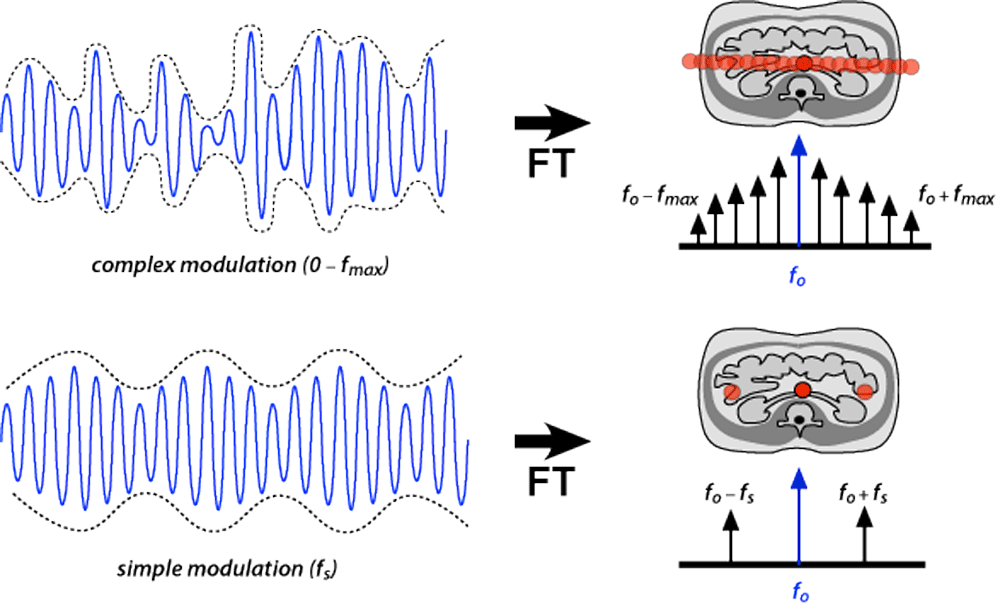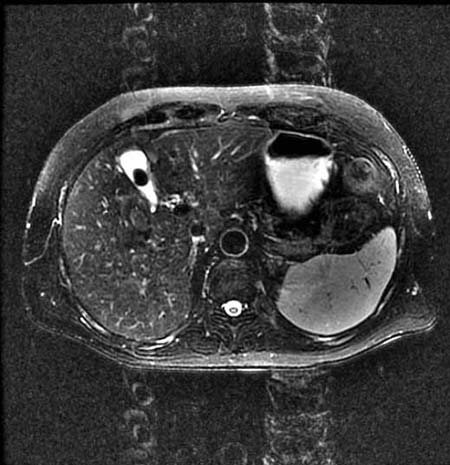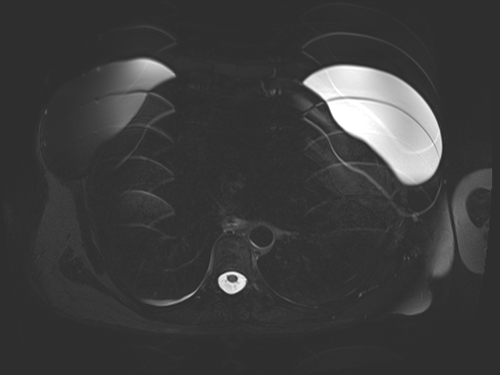|
Discrete "ghost" artifacts may occur along the phase-encode direction whenever the position or signal intensity of imaged structures within the field-of-view vary or move in a regular (periodic) fashion. Pulsatile flow of blood or CSF, cardiac motion, and respiratory motion are the most important patient-related causes of ghost artifacts in clinical MR imaging. The intensity of these ghost artifacts increases with the amplitude of the periodic motion, as well as with the signal intensity of the moving tissue.
If the motion is nonperiodic (e.g., peristalsis), then discrete ghosts will not be formed. Instead, diffuse image noise will be generated and propagate widely along the phase-encode direction.
The spacing of discrete ghost artifacts in the image depends upon the principal direction of motion (along the x-, y-, or z-axis), the magnitude of the displacement, and the periodicity of the motion relative to the phase-sampling interval. In general, the more rapid the motion, the more widely spaced will be the ghosts. |

Appearance of motion artifacts depends on how they modulate the principal imaging frequency (fo). Random/aperiodic motion represents a wide range of complex modulating frequencies. Fourier transform (FT) results in a spread of upper and lower side bands and a diffuse, unfocused artifact. Simple/regular/periodic motion at frequency fs results in discrete sidebands that appear as ghosts on either side of the primary image.
For routine 2DFT MR imaging, the interval between successive phase samples is equal to TR x NEX (because repeated excitations are generally performed before incrementing the phase-encode gradient). Ghost artifacts will be most closely spaced when the period of motion (TP) equals TR x NEX. Conversely, ghost artifacts will be most widely spaced when TP = 2 x TR x NEX.
Advanced Discussion (show/hide)»
No supplementary material yet. Check back soon.
References
Axel L, Summers RM, Kressel HY, Charles C. Respiratory effects in two-dimensional Fourier transform MR imaging. Radiology 1986; 160:795-801.
Storey P, Chen Q, Li W, et al. Band artifacts due to bulk motion. Magn Reson Med 2002; 48:1028-1036.
Wood ML, Henkelman RM. MR image artifacts from periodic motion. Med Phys 1985; 12:143-151.
Axel L, Summers RM, Kressel HY, Charles C. Respiratory effects in two-dimensional Fourier transform MR imaging. Radiology 1986; 160:795-801.
Storey P, Chen Q, Li W, et al. Band artifacts due to bulk motion. Magn Reson Med 2002; 48:1028-1036.
Wood ML, Henkelman RM. MR image artifacts from periodic motion. Med Phys 1985; 12:143-151.
Related Questions
Why are motion artifacts propagated in the phase-encode direction instead of the frequency-encode direction?
Why are motion artifacts propagated in the phase-encode direction instead of the frequency-encode direction?


